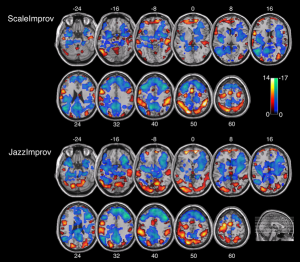Due out on August 8th, Lucy from Luc (The 5th Element, The Professional, The Extraordinary Adventures of Adèle Blanc-Sec) Besson and starring Scarlett Johansson looks awesome. Check it out.
Yeah, but…
She’s got superpowers, the eyes of multiple species, she can change matter at the atomic level, she can see radio waves, her brain is amped up to work faster and better and of course, she’s telekinetic! Sweeeeeet – she’s like the daughter of Akira and Jean Grey.
But – there’s always a but…you probably caught it too. At around 1:14 in, Morgan Freeman’s character says, “It is estimated that most human beings only use 10% of the brain’s capacity. Imagine if we could access 100%…interesting things begin to happen.”
That’s something you hear a lot of (albeit not from scientists or neurologists in the real world) – that we only use 10% of our brain’s “potential” or “power” or “ability” or something. Is that true?
If you said yes, don’t feel bad. In a poll about brain science and brain health commissioned by the Michael J. Fox Foundation in 2013, 65% of Americans believe this is true.
But is it really true? In a word – no.
In a few more words, it gets interesting really quickly when you try to find out where the idea that at any given moment 90% of your brain is twiddling its thumbs, thinking things like, “I want to rearrange matter at the atomic level, but they never ask me to.”
It’s safe to say that we only understand how 10% of the brain functions. But that doesn’t mean we’re all “Lucys” if we could just get the right drug combo tucked into our tummies in a leaking bag.
With this kind of bending of science, I like to look at where it came from first. “We only use 10% of our brains” is most often traced back to psychologist William James who wrote in The Energies of Men (1907) that “We are making use of only a small part of our possible mental and physical resources.” Of course, that was also around the infancy of brain science and the accompanying brain “surgery” where it was discovered (by accident or on purpose) that hey, sometimes people who had a chunk of their brain taken out do just fine. Cue flashbacks of American Horror Story: Asylum‘s lobotomy scenes that I was working hard to forget.
It has continued from there – attributions to a misquote from Albert Einstein and claims by countless intellectuals (although you may want to question their credentials) and others over the decades have lodged this idea firmly in popular culture, even though its origin is long-lost to history – although, check out of the D News link below for what allowed James to say what he said, and let an involuntary shudder run down your spine about the “experiment.”
As a result, we see things like Lucy, which is by no means the only piece of pop culture to play with the idea recently – heck, Limitless was just out in 2011 – that think by “activating” the full 100% of our brains = superpowers. It’s an attractive notion – we use 10% of our brains for the boring mundane stuff of life, and we’ve got this “90%” black box that is able to do…something, right? That’s what the psychics say, at least.
But it’s not true.
The average human brain has around 80-100 billion neurons, and perhaps roughly the same to wildly more glial cells that support the neurons. Virtually all regions of the brain are active during any given 24 hour period. Unless a part of the brain is damaged, everything works – this is shown by PET (positron emission tomography) and fMRI (functional magnetic resonance imaging) scans of active brains (see image below). True, less complicated tasks will use less overall regions of the brain, but more complex tasks for the brain will get more regions of the noodle to pitch in and help. A good analogy? You don’t use every single muscle in your body every minute of the day, right?
Of course, on the more tragic side, this myth is proven true by injury to the brain and the often life-altering changes it can bring. Yes, parts of the brain can show a remarkable plasticity and adapt in the case of injury to do the work of other parts, but damage enough, and…well, there’s no black box holding back some “90%” that can be tapped.
Also – the human brain uses 20% of the body’s energy to keep running. That’s a huge amount for an organ that’s fairly small in relation to the rest of the body (it’s okay, but it’s no liver or skin). An organ only operating at 10% needs that much energy for why? (which also puts out the idea that a brain operating at “100%” wouldn’t be adequately fed by a human with its current digestive system). Also – if you don’t use brain cells, they wither away – something also seen in diseases that affect the brain. Put both of those together and you come to the logical conclusion – if the brain isn’t using 90% of its abilities or neurons, they’re not going to be fed, and as a result, they’re going to wither away, and won’t be there on that day that you take that pill, or otherwise want to wake up your ESP.
This isn’t to say that everything about the brain is known – the groupings of neurons in various areas that act together to produce what we call consciousness as well as the idea of self – that, along with dozens of other topics is stuff for the future. But as for magical powers hiding out, just waiting to be tapped once humanity realizes its full potential – great for movies, but not for reality.
But Lucy looks like fun.
Oh, also – without all the baggage that has been put on to James’ quote over the years, he probably was talking about how people don’t reach their mental potential because we don’t challenge ourselves mentally. We can all fix that.
For More:
Scientific American: Do People Only Use 10 Percent of their Brains?










